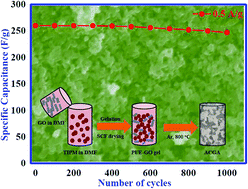Graphene oxide aided structural tailoring of 3-D N-doped amorphous carbon network for enhanced energy storage
Abstract
Organic aerogels are a class of material most suited for their transformation into electrically conducting porous carbon networks. Typically, polymeric aerogels are prepared via base- or acid-catalyzed polymerization of organic monomers. In this work, we report the first synthesis of graphene oxide (GO) induced gelation of poly(urethane–amide) networks which upon pyrolysis yield monolithic N-doped amorphous carbon/reduced GO (rGO) aerogels. Here GO plays a significant multifunctional role of (i) inducing the gelation of poly(urethane–amide) networks; and (ii) tailoring the physical properties of N-doped amorphous carbon–rGO aerogels. The resulting aerogels were characterized by X-ray diffraction (XRD), N2 sorption porosimetry, X-ray photoelectron spectroscopy (XPS), Fourier-transform infrared spectroscopy (FT-IR), Fourier-transform Raman spectroscopy (FT-Raman), field emission scanning electron microscopy (FE-SEM), and high resolution transmission electron microscopy (HR-TEM) which support the formation of a highly porous carbon/rGO network. Importantly, the obtained N-doped amorphous carbon/rGO aerogels (0.76 wt% of GO) are electrically conducting with a pore volume, pore diameter and surface area of 0.39 cm3 g−1 (69% mesopores), 36 nm and 260 m2 g−1 respectively. The significantly enhanced specific capacitance is derived from the tailored 3-D mesoporous structure of the N-doped amorphous carbon/rGO aerogels which consist of large pore volumes and a predominant number of accessible mesopores allowing a low resistance path for inward and outward diffusion of electrolyte ions and endowing a high charge storage capability resulting in a superior specific capacitance of 260 F g−1. The nanoporous networks in the as-prepared N-doped amorphous carbon/rGO serve as channels for quick ionic and electronic conduction. In addition to the enhanced physical properties achieved by addition of a minimal amount of GO, the increased specific capacitance can also be credited to the effective N-doping in ACGA-2 resulting in alteration of the electronic structure of rGO with an increase in charge carrier density, and modification of interfacial and quantum capacitance.


 Please wait while we load your content...
Please wait while we load your content...